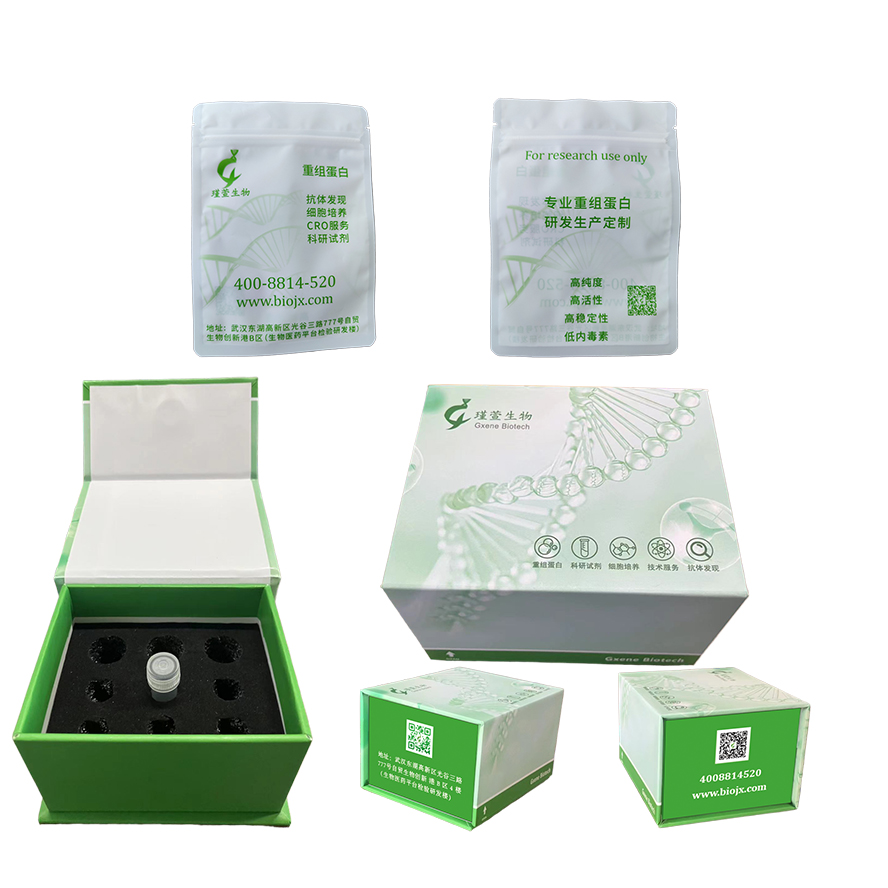CXCL16 是一种膜结合趋化因子。CXCL16以可溶性或跨膜形式表达,可在多种细胞类型中观察到,包括炎症细胞(如巨噬细胞、中性粒细胞、树突状细胞和单核细胞)和非炎症细胞(如肺上皮细胞和肾细胞)。CXCL16在天然免疫屏障和自身免疫性疾病的发生发展中发挥着重要作用。
CXCL16 蛋白在小鼠、大鼠和狗 CXCL16 蛋白之间具有较低的同源性。
CXCL16 主要表达于抗原呈递细胞 (APC) 表面,由趋化因子结构域(约 89 个氨基酸)组成,是一种粘蛋白型茎(约 110 个氨基酸)、单次跨膜结构域(约 20 个氨基酸)和胞质尾(约 27 个氨基酸)。CXCL16 是 CXCR6 受体的唯一配体。可溶性CXCL16诱导CXCR6+细胞(包括Th1细胞、NK细胞和活化的 CD8+ T 细胞)的迁移、M2巨噬细胞浸润、APC 和 CD8+ T 细胞之间的相互作用、细胞免疫反应和炎症反应以及发育胸腺细胞。膜结合的 CXCL16 可以促进 CXCR6+ 细胞的粘附。CXCL16 特异性结合氧化低密度脂蛋白 (OxLDL),导致其内化和降解。CXCL16 可能在动脉粥样硬化病变的形成中发挥重要作用。巨噬细胞和树突状细胞上的 CXCL16 介导大肠杆菌和金黄色葡萄球菌等细菌的粘附和吞噬作用,而细菌识别则由 CXCL16 的趋化因子结构域介导。
CXCL16 不仅是一种趋化因子,也是一种多功能蛋白。CXCL16 和 CXCR6 与多种炎症性疾病有关,例如肾小球肾炎、肺部疾病、动脉粥样硬化、冠状动脉疾病、类风湿性关节炎和许多与炎症相关的癌症。CXCL16 的趋化因子结构域对大肠杆菌和金黄色葡萄球菌发挥有效的抗微生物活性。CXCL16 通过吸引表达 CXCR6 的细胞(例如激活的 T 细胞和 NKT 细胞)充当先天免疫的介质。CXCL16 也是人类表皮角质形成细胞先天免疫反应的新型介质。
Measured by its ability to chemoattract BaF3 mouse pro‑B cells transfected with mouse CXCR6. The ED50 forthis effect is 10-50 ng/mL.
种属
After reconstitution, the protein solution is stable at -20°C for 3 months, at 2-8°C for up to 1 week.未开盖的干粉蛋白在 -20°C至-80°C可保存12个月;
复溶之后,蛋白溶液在-20°C及以下可保存3个月,在2-8℃可保存1周。
背景信息
C-X-C motif chemokine 16, also known as Small-inducible cytokine B16, SR-PSOX, and CXCL16, is a single-pass type I membrane protein which belongs to the intercrine alpha (chemokine CxC) family. CXCL16 exists in transmembrane and soluble forms. The transmembrane form acts as a scavenger receptor for oxidised LDL whereas the soluble form acts a chemoattractant for mainly CD8+ T cells. CXCL16 is a protein which shares pattern recognition receptor functions, relevant for adhesion and phagocytosis of bacterial products, with the properties of an adhesion molecule and inflammatory chemokine. CXCL16/SR-PSOX is an interferon-gamma-regulated chemokine and scavenger receptor for oxidized low-density lipoprotein that is expressed in atherosclerotic lesions. Proteolytic cleavage of membrane-bound CXCL16 releases soluble CXCL16, which may promote migration of effector T cells and augment a proatherogenic inflammatory response. CXCL16/SR-PSOX can be a potential player in atherogenesis. Enhanced expression of CXCL16 has been demonstrated in atherosclerotic plaques and several properties have been attributed to CXCL16 that could influence the atherosclerotic process. Following in vitro studies suggested that as an adhesion molecule CXCL16/SR-PSOX might mediate T-cell adhesion to the endothelium, as a chemokine-drive T-cell migration, stimulate cell proliferation and elicit inflammatory phenotype in smooth muscle cells (SMC) and, finally, as a scavenger receptor-mediate uptake of atherogenic lipoproteins by macrophages and SMC. CXCR6 and its ligand CXCL16 in regulating metastasis and invasion of cancer. CXCR6 and CXCL16 are up-regulated in multiple cancer tissue types and cancer cell lines relative to normal tissues and cell lines. In addition, both CXCR6 and CXCL16 levels increase as tumor malignancy increases. Thus, CXCL16 and CXCR6 may mark cancers arising in an inflammatory milieu and mediate pro-tumorigenic effects of inflammation through direct effects on cancer cell growth and by inducing the migration and proliferation of tumor-associated leukocytes.


